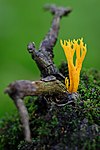Dacrymycetales
| Dacrymycetales | |
 | |
| Systematik | |
|---|---|
| Domän | Eukaryoter Eukaryota |
| Rike | Svampar Fungi |
| Division | Basidiesvampar Basidiomycota |
| Klass | Dacrymycetes |
| Ordning | Dacrymycetales |
| Vetenskapligt namn | |
| § Dacrymycetales | |
| Auktor | Henn. 1897 |
| Typsläkte | |
| Dacrymyces Nees (1817) | |
Dacrymycetales[1][2] är en ordning inom basidiesvamparna som tillsammans med den 2013 nybeskrivna ordningen Unilacrymales utgör klassen Dacrymycetes. Dacrymycetales delas ofta upp i de två familjerna Dacrymycetaceae[3][4] och Cerinomycetaceae[5][6], vilka tillsammans omfattar cirka 110 arter fördelade på nio släkten (2013). Släktskapsförhållandena inom Dacrymycetales är dåligt utredda och flera släkten, särskilt Dacrymyces, förefaller vara polyfyletiska.[7][8]
Ordningen upprättades 1897 (som Dacryomycetineae) av den tyske mykologen Paul Christoph Hennings.[9]
Fruktkropparna är av varierande form: resupinata (det vill säga "skorplikt" fastvuxna vid underlaget) i Cerinomycetaceae; kuddlika, spadformiga, greniga etcetera i Dacrymycetaceae. De är vanligtvis gula till orangefärgade av karotenoider och har en gelé- eller broskartad konsistens. De tvåsporiga basidierna är stämgaffellikt tvågrenade, vilket skiljer ordningen från Unilacrimales som har ogrenade cylindriska basidier. Sporerna är vanligen septerade och parentesomerna är inte perforerade. Svamparna är saprotrofer och orsakar vanligtvis brunröta på trä (två arter orsakar troligen vitröta).[10][11]
- Dacryopinax spathularia
Dacrymycetaceae - Guepiniopsis buccina
Dacrymycetaceae - Spor med tre septa hos Dacrymyces stillatus.
- Stämgaffellika tvåsporiga basidier hos Dacrymyces chrysospermus.
Referenser
- ^ Dacrymycetales på Index Fungorum.
- ^ Dacrymycetales på Dyntaxa.
- ^ Dacrymycetaceae på Index Fungorum.
- ^ Dacrymycetaceae på Dyntaxa.
- ^ Cerinomycetaceae på Index Fungorum.
- ^ Cerinomycetaceae på Dyntaxa.
- ^ Se Shirouzu et al. (2013), sid. 1110 och 1121-1122.
- ^ T. Shirouzu, K. Hosaka, K.-O. Nam, B.S. Weir, P.R. Johnston & T. Hosoya, 2017, Phylogenetic relationships of eight new Dacrymycetes collected from New Zealand, Persoonia 38, sid. 156-169.
- ^ P. Hennings, november 1897, Dacryomycetineae. I Adolf Engler & Karl Prantl, 1900, Die Natürlichen Pflanzenfamilien, vol 1, del 1**, sid. 96-102.
- ^ Takashi Shirouzu, Dai Hirose & Seiji Tokumasu, 2009, Taxonomic study of the Japanese Dacrymycetes, Persoonia 23, sid. 16-34.
- ^ Takashi Shirouzu, Dai Hirose, Franz Oberwinkler, Norihiro Shimomura, Nitaro Maekawa & Seiji Tokumasu, 2013, Combined molecular and morphological data for improving phylogenetic hypothesis in Dacrymycetes, Mycologia, 105:5, sid. 1110-1125.
Media som används på denna webbplats
Författare/Upphovsman: This image was created by user Ian Dodd (kk) (www.kundabungkid.com) Australia (kundabungkid) at Mushroom Observer, a source for mycological images.
You can contact this user here., Licens: CC BY-SA 3.0
For more information about this, see the observation page at Mushroom Observer.
Författare/Upphovsman: This image was created by user Robert(the 3 foragers) (the3foragers) at Mushroom Observer, a source for mycological images.
You can contact this user here., Licens: CC BY-SA 3.0
For more information about this, see the observation page at Mushroom Observer.
Författare/Upphovsman: Miika Silfverberg, Licens: CC BY-SA 2.0
Yellow Stagshorn Fungus (Calocera viscosa) Dysmorodrepanis 14:25, 28 May 2008 (UTC)
Författare/Upphovsman: Andreas Kunze, Licens: CC BY-SA 3.0
Common Jelly Spot (Dacrymyces stillatus) - Spore with septa
Författare/Upphovsman: This image was created by user Sava Krstic (sava) at Mushroom Observer, a source for mycological images.
You can contact this user here., Licens: CC BY-SA 3.0
Dacrymyces chrysospermus Berk. & M.A. Curtis
Författare/Upphovsman: This image was created by user Paul Derbyshire (Twizzler) at Mushroom Observer, a source for mycological images.
You can contact this user here., Licens: CC BY-SA 3.0
For more information about this, see the observation page at Mushroom Observer.










